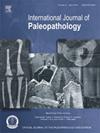To evaluate the presence of a trauma that results in pelvic ring disruption and its clinical implications in two individuals from ancient Egypt.
Two complete skeletons of adult women, dated to the Middle Kingdom (c. 1980–1760 BCE), from two tombs in the necropolis of Qubbet el-Hawa (Aswan, Egypt).
The anatomical elements were examined macroscopically in Egypt.
Unilateral sacroiliac luxation with disruption of the pubic symphysis was detected in both individuals. The presence of an overlapped symphysis was evident in female QH34aa. A healed fracture of the iliopubic ramus are present in female QH122. Antemortem bone alterations in the pelvis demonstrate that they survived the trauma.
Pelvic trauma due to a lateral compression was detected in the os coxae. Both women survived but probably had severe sequelae that impaired their quality of life. At least one of them might have received some type of medical treatment.
Both cases shed light on pelvic fractures, their mechanisms of production, and their effects on bone and its functionality, as well as revealing possible associated lesions of soft tissues and vital organs.
The pelvis, or at least the pubic symphysis, must be well preserved to allow the correct diagnosis of this type of lesion.
Studies are warranted on the detection of this type of fracture, focusing on the subtle bone changes that indicate its presence. There is also a need to develop methodologies that combine the study of bone and soft tissue alterations.


